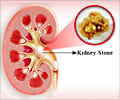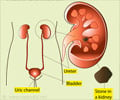- Lithotripsy - (https://www.kidney.org/atoz/content/lithotripsy)
- Kidney Stone Treatment: Shock Wave Lithotripsy - (https://www.kidney.org/atoz/content/kidneystones_ShockWave)
- About Lithotripsy - (http://www.urologists.org/article/procedures/lithotripsy)
What is Lithotripsy or Extracorporeal Shock Wave Lithotripsy (ESWL)?
Lithotripsy is a process that uses acoustic or high intensity sound waves (called shock waves) to break stones in the kidney, ureter, bladder and rarely those in pancreas or common bile duct.
After the procedure, tiny pieces of stone pass out of body in urine or through other natural passages.

Purpose of Lithotripsy
It is used for removing kidney stones without surgery that causes –
- Pain or colics
- Bleeding
- Damage to kidney due to blockage
- Urinary tract infections and fever
Small stones in the ureter that are less than 4 mm in size will normally pass spontaneously but the larger ones may get stuck and cause symptoms such as colics and /or fever.
There are two types of lithotripsy techniques:
- Extracorporeal shock wave lithotripsy (ESWL)
- Intracorporeal (Endoscopic lithotripsy)
Intracorporeal lithotripsy further involves:
- Laser lithotripsy
- Electrohydraulic lithotripsy
- Mechanical lithotripsy
- Ultrasonic lithotripsy
Lithotripsy Techniques
Extracorporeal Shock Wave Lithotripsy (ESWL)Extracorporeal as the name suggests is done outside the body. Here, high energy shock waves are passed through the body for breaking stones into pieces as small as grains of sand. Due to their small size, these pieces can pass out from the body along with the urine.
ESWL Procedure
ESWL revolutionized the
The body is positioned in such a way that the stone is first correctly localized and then targeted using the high intensity shock waves. The patient should lie as still as possible during the procedure. Once the patient is comfortable and the stone is located the energy generator is activated to produce the required intensity to break the stones. For the energy to pass through the patient’s body, it needs to be in contact with a soft cushion or membrane that is smeared with jelly. About 1000 to 2000 shock waves are required for crushing the stones. The time required to complete the treatment is about 45 to 60 minutes.
During the Procedure
Inform Doctor – If you are having a fever or taking blood thinning tablets or if you are pregnant.
Change Before the Procedure – Forthe ESWL procedure you will be asked to wear a hospital gown and lie on the ESWL table with the back on top of a soft, water-filled cushion.
Painkillers & Anesthesia – An intravenous medicationfor pain and relaxation and sometimes an antibiotic is administered.
Small children will require

Stone Localization - The doctor or the technician doing the procedure will use the X-ray machine or ultrasound probe for localizing the stone. This will take about 5 minutes.
Putting on the Headsets - As the machine makes loud thumping noise, it is best to use sound mufflers or listen to music using headsets.
Switching on High Energy Generator – Once the stone is located the doctor will ask you remain as still as possible and switch on the generator to start breaking the stone. The intensity at first is low and as you tolerate the minimum discomfort (you will feel like someone is thumping you gently on your back) the intensity is upped till you can tolerate it.
The generator produceshigh energy acoustic or sound waves called shock waves that travel through the body until they encounter the stone. These waves hit the stone repeatedly at a frequency that can vary from 30 to 90 times a minute. Once you are settled on the machine the frequency and intensity will be increased to ensure that the stone starts getting fragmented.
Frequent Monitoring by Ultrasound or X-ray - There will be frequent monitoring with
After the Procedure
Patient is asked to stay for about an hour and then be allowed to return home if everything goes well. Also,
Blood in Urine or Hematuria – You may find that the urine is red after ESWL, it is due to passage of
Fever – A small rise in temperature maybe experienced for a day. This again is not unusual and a

Pain – Pain due to passage of stones maybe experienced or sometimes a large fragment may block the tube (ureter) that connects the kidney to the bladder. You will be given a supply of painkillers and you should use them as advised to prevent pain or to overcome it.
Medication to Ease Passage of Small Stones – Some units will give you a tablet for this purpose and you should take them for a few days till the stones get cleared.
X-ray or Ultrasound on Follow up Visit – You will require these when you go back to see the doctor to view the status of the stone.
Advantage and Disadvantages of ESWL
Advantages:
- ESWL is a good procedure for stones that are not too hard and are less than 1.5 to 2 cm in size in the kidney. Most such stones will fragment into sand like particles and pass out easily.
- ESWL is an outpatient procedure that does not require anesthesia or admission.
- ESWL procedure is a non-invasive and a non-surgical procedure that is well tolerated.
- Almost 80% of all stones can be treated quite safely by ESWL.
Disadvantages:
- Treatment results of large stones are not as good as for smaller stones.
- More than one session maybe required to clear the stone.
- A pre-procedure Double J stent maybe required before undertaking ESWL. The stent is a thin tube between the kidney and bladder to prevent stones blocking the ureteric tube and causing obstruction to passage of the urine.
- Hard stones do not fragment despite more than one session and require other methods of treatment.
- Passage of stone may cause acute colics, pain and discomfort.
- It cannot be used if you have any bleeding disorder or if you are pregnant.
Intracorporeal Lithotripsy
If stones can't be fractured or broken down by extracorporeal lithotripsy due to their position, density, or size, an endoscopic approach is preferred by surgeons. Intracorporeal lithotripsy is often done via
- Lasers
- Ultrasound shock waves
- Mechanical devices
Graspers or wire basket often used for extracting the pieces that are shattered or are left behind and allowed to pass out of urine at the same time.
This procedure is done under regional or general anesthesia and requires hospitalization for a day or two. Some units do it as a day procedure.
A catheter and a Double J stent after the procedure is not unusual. The catheter is removed after a day or two and stent after a week or two.
Stent removal is an additional procedure and requires a day’s admission. This may mean additional cost. Make sure you check with your urologist, if he intends to use a stent after the intra-corporeal lithotripsy.
Risks with Lithotripsy
ESWL or lithotripsy is safe procedure most of the time. Consult with your doctor for possible complications like:
- Infection in kidneys

- Bleeding around kidney
- Pieces of stone that blocks flow of urine from kidney (this can cause severe pain or damage to kidneys)
- Pieces of stone being left inside the body (more treatments may be required)
- Problems in kidney function after the procedure
 MEDINDIA
MEDINDIA
 Email
Email






